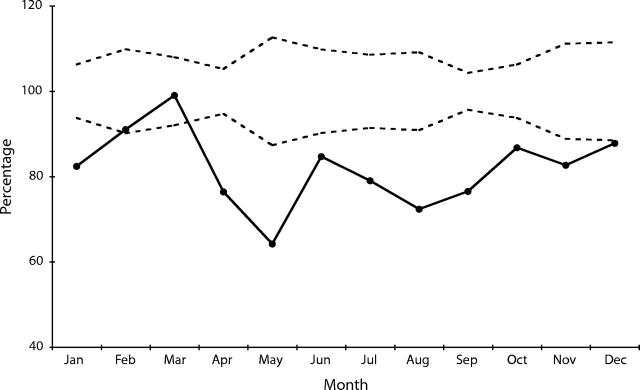Chang et al., using National Health Insurance data, reported significant reductions in medical service utilization at the peak of the severe acute respiratory syndrome (SARS) epidemic in Taiwan.1 This finding may be supported by other evidence from Hong Kong: lowered tuberculosis notifications. Our assumption is that deterred health care seeking during the epidemic resulted in the lowered detection, and thus notification, of tuberculosis.
To examine the recent trend of tuberculosis notifications in Hong Kong, we calculated the average monthly number of notifications (incidence) per 100 000 population and its 95% confidence interval from January 1997 to December 2002, using the surveillance data and the midyear population of each year,2,3 and compared the trend with that in 2003. To remove monthly fluctuations, we standardized the 1997–2002 average as 100 for each month (Figure 1 ▶).
FIGURE 1—
Monthly tuberculosis notification rate in 2003 (solid line) and 95% confidence interval (dotted line) of the 1997–2002 average notification rate standardized as 100.
The number of monthly notifications in 2003 was generally lower than the average for 1997–2002, with apparent reductions during the SARS epidemic in April and May. Absolute difference (the number of notifications in 2003 minus the average for 1997–2002) was −129 in April and −240 in May, while that in other months was −83 on average. The number of notifications was lower in 2003 than in previous years until the end of the year.
During the epidemic, people with possible cases of tuberculosis, like people with other adverse health conditions, must have hesitated to seek treatment at medical facilities. Telephone surveys of 1397 Hong Kong residents conducted throughout the epidemic found that more than 70% avoided visiting hospitals during the epidemic.4
The lowered number of notifications of tuberculosis should not be a reflection of actual reductions in incidence resulting from reduced human contact during the epidemic. Since the incubation period of tuberculosis is relatively long, the effects of reduced contact in preventing the infection, if any, should be revealed much later. Thus, the lower number of notifications during the epidemic more likely owes to deterred health care seeking.
The lower number of notifications may have been observed because of underreporting during the epidemic. Health professionals were possibly too occupied in dealing with the epidemic to report tuberculosis cases to the health authority. We are, however, unsure whether this would explain the notification trend following the end of the epidemic.
In sum, case detection of tuberculosis may have been hindered by the SARS epidemic. People with undetected tuberculosis may have continued spreading the disease while treatment was delayed. We should not overlook such potential health hazards of the epidemic.
References
- 1.Chang HJ, Huang N, Lee CH, Hsu YJ, Hsieh CJ, Chou YJ. The impact of the SARS epidemic on the utilization of medical services: SARS and the fear of SARS. Am J Public Health.2004;94:562–564. [DOI] [PMC free article] [PubMed] [Google Scholar]
- 2.Disease Prevention and Control Division, Department of Health. Statistics on communicable diseases. Available at: http://www.info.gov.hk/dh/diseases/index.htm. Accessed May 7, 2004.
- 3.Census and Statistics Department. Population by sex. Available at: http://www.info.gov.hk/censtatd/eng/hkstat/fas/pop/by_sex_index.html. Accessed May 7, 2004.
- 4.Lau JT, Yang X, Tsui H, Kim JH. Monitoring community responses to the SARS epidemic in Hong Kong: from day 10 to day 62. J Epidemiol Community Health.2003;57:864–870. [DOI] [PMC free article] [PubMed] [Google Scholar]



